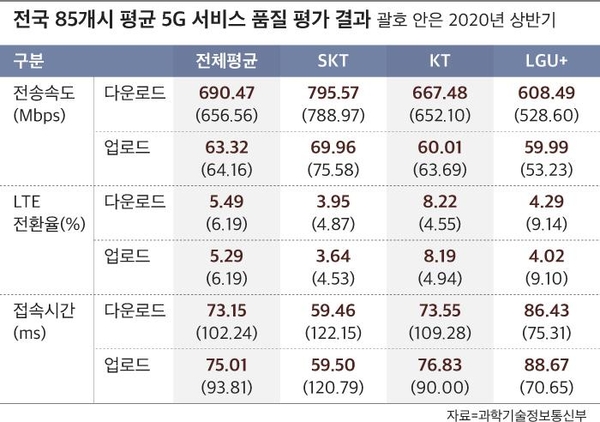Input 2020.12.30 15:02 | Revision 2020.12.30 16:29
In the second half of this year, the quality of 5G (5th generation) mobile communication has improved compared to the first half, but the quality of 4G (LTE) has declined compared to last year. There are 55 million LTE subscriber lines nationwide. Considering that it is five times the number of 5G subscribers, consumer complaints about the quality of communication inevitably increase.
The Ministry of Science, ICT and ICT and the Korea Intelligent Information Society Agency (NIA) announced’Telecommunication Service Coverage Inspection and Quality Evaluation for the Second Half of 2020′ through a briefing at the Government Sejong Office on the 30th. It has been about 5 months since the ‘5G communication service quality evaluation result for the first half of 2020’ was announced in August. This is the second quality evaluation, including 5G, following the first half survey announced in August of this year.
The subject of the survey was expanded from Seoul and six metropolitan cities to major administrative buildings in 85 cities nationwide. As a result of the quality evaluation, it was found that SK Telecom was the most advanced in 5G speed, LG Uplus for service coverage, and KT for multi-use facility network construction.
◇ Improved 5G quality… 20 times faster’dream 5G’ service is still

According to the results of checking the overall coverage map of the three telecommunications companies, Seoul Metropolitan Government provides 5G services in an area of about 478.17㎢ on average for the three telecommunications companies and about 1,417.97㎢ in six metropolitan cities. It turned out to be available.
However, it is pointed out that there is still a big gap from the 5G quality expected by consumers as the base station in the 28GHz (Gigahertz) band, also called’real 5G’, has not been built. In the early stages of commercialization of 5G, carriers promoted that they were 20 times faster than LTE, but the current level is only 4.5 times.
◇Three telecommunications companies neglect LTE maintenance… Factors deteriorating the quality of LTE infrastructure utilization in 5G
The bigger problem is LTE. The LTE network is currently the communication infrastructure most used by the nation. According to the Ministry of Science and ICT, the number of Korean mobile telecommunication subscribers as of the end of August this year was 70 million, 170.
LTE services are 5454 million, 5G 866 million, 3G 6.2 million, and 2G 610,000. As of the end of September, the Korean population is 50 million. Only LTE subscription lines exceed the national population.
However, the LTE service in this survey showed an average download speed of 153.10 Mbps (5.43 Mbps ↓ compared to last year’s 158.53 Mbps) and 39.31 Mbps (3.52 Mbps ↓ compared to last year’s 42.83 Mbps), which fell for the first time since the service.

In response, Jin-bae Hong, communication policy officer of the Ministry of Science and ICT, said, “It is necessary to understand that the LTE speed has decreased in detail, but the level of maintenance in rural areas seems to be worse (than last year).” “Because it is being used, it is understood that this aspect is reflected.” Since 10 million LTE users have moved to 5G, there is an effect of sharing frequencies.
Policy Officer Hong emphasized, “Since LTE is a service that is still used by over 50 million users, we will make sure that quality control (of telecommunications companies) is not neglected with stricter measures next year.”
